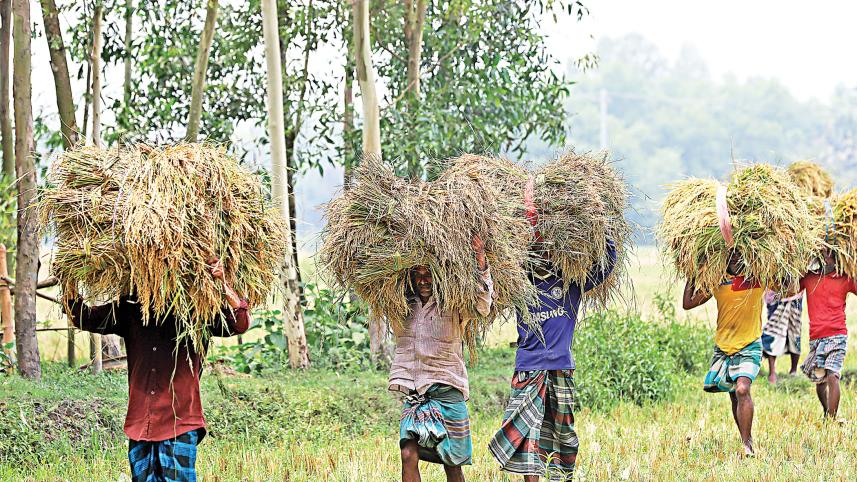Post-harvest losses eat up 21m tonnes of food a year: CPD

Bangladesh may have achieved self-sufficiency in food production but annually suffers post-harvest losses of nearly 21 million tonnes, which experts warn are eroding food security, undermining farmers' livelihoods, and costing the economy billions.
To give some perspective, annual average per capita rice consumption is around 118 kilogrammes, as per a 2022 survey of the Bangladesh Bureau of Statistics.
The concern was raised at a policy dialogue jointly organised by the Centre for Policy Dialogue (CPD), the Embassy of Denmark, and the World Food Programme (WFP) at Pan Pacific Sonargaon Dhaka yesterday.
Farida Akhter, adviser to the Ministry of Fisheries and Livestock, said while Bangladesh had made remarkable strides in food production, it was still failing to protect that progress because of staggering post-harvest losses.
"We are discussing a very important issue—moving towards zero food loss and waste. Although we may not reach that goal by 2030, I believe we can make meaningful progress," she said.
Akhter urged policymakers to prioritise investment in storage facilities, fair pricing mechanisms, and behavioural change, stressing that without systemic action, the problem would persist.
Citing World Bank and WFP estimates, she pointed out that 15.5 million to 16 million people in Bangladesh suffer from food insecurity, a situation projected to continue into 2025 despite production gains.
She emphasised the stark inequality in food consumption. "Some segments of society overconsume while others struggle to meet basic needs. This imbalance intensifies waste and weakens overall food security," she said.
Akhter drew attention to significant losses in agriculture, fisheries, and livestock due to inadequate storage facilities, weak infrastructure, and lack of a fair price support system for farmers.
"Food is perishable and cannot be treated like industrial goods," she cautioned. "Until we address waste and inequality, hunger will persist, and sovereignty will remain out of reach."
Echoing her concerns, Anders Karlsen, chargé d'affaires of the Embassy of Denmark, said food loss and waste represented a global challenge and translated into "simple economic losses."
He noted that food is frequently lost during transportation, at the farm gate, and increasingly because of extreme weather events triggered by the climate crisis.
Highlighting the strong partnership between Bangladesh and Denmark in food and agriculture, Karlsen said greater cooperation was needed to build a sustainable food value chain that protects both producers and consumers.
Dia Sanu, deputy Food and Agriculture Organization (FAO) representative, said food loss in Bangladesh remained "alarmingly high."
A recent FAO study found post-harvest losses of 17.8 percent for paddy, 17.6 percent for wheat, and 17 percent to 32 percent for fruits and vegetables, with mango showing the highest loss at 31.7 percent.
Animal products were not spared either, with losses of 8 percent for milk, 13 percent for eggs, and 17 percent for poultry. In fisheries, poor icing and handling practices led to an average loss of 12.5 percent.
To combat these challenges, the FAO has introduced initiatives in Dhaka to improve food distribution systems and in Cox's Bazar, where 25 aggregation centres train farmers in washing, grading, and safe transport of fresh produce.
"Food waste is highest among affluent households. Tackling this requires both stronger supply chains and greater public awareness," Sanu said.
Jesse Wood, the WFP's deputy country director and officer-in-charge in Bangladesh, underscored the economic toll of the crisis.
"Food loss is not only about hunger—it is about billions lost from the national economy. Every kilogramme wasted is money out of farmers' pockets and fewer resources for development," he said.
The WFP estimates that 25 percent to 40 percent of fruits and vegetables, worth $2.4 billion annually, rot before reaching consumers due to poor storage and cold chain facilities.
Similarly, between 8 percent and 15 percent of rice and nearly 30 percent of fish are wasted post-harvest, while poultry incurs about 17 percent losses.
To respond, the WFP has set up 62 aggregation centres in Cox's Bazar and 4 in Kurigram, where farmers receive training, storage access, and marketing support.
These centres also supply quality food to refugee camps and vulnerable communities. Looking ahead, the WFP is rolling out hermetic storage, mechanised drying, and digital traceability tools to further cut losses.
"Cutting waste is the fastest way to save money, protect farmers, and feed more people," Wood stressed.
The session was moderated by Fahmida Khatun, executive director of the CPD, and attended by government representatives, including Mohammed Yasin, additional secretary to the Ministry of Food.



 For all latest news, follow The Daily Star's Google News channel.
For all latest news, follow The Daily Star's Google News channel.